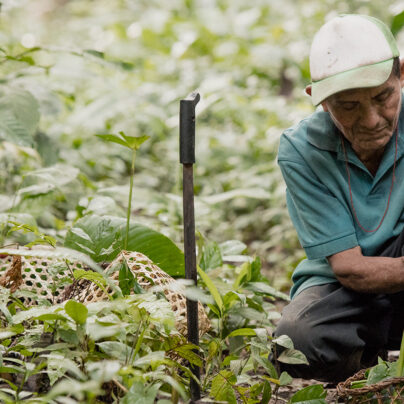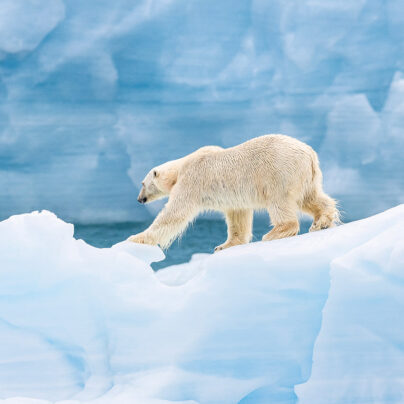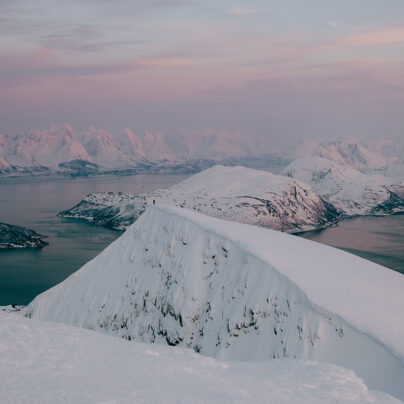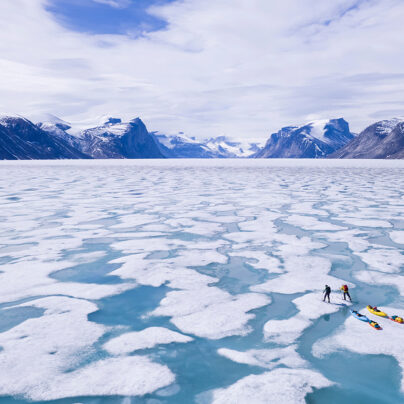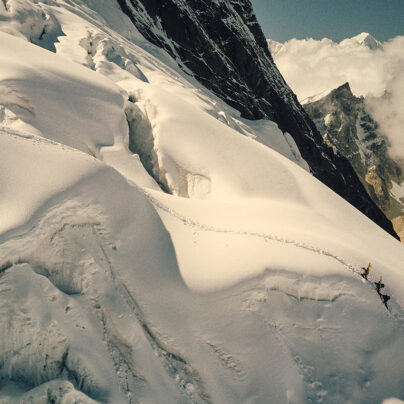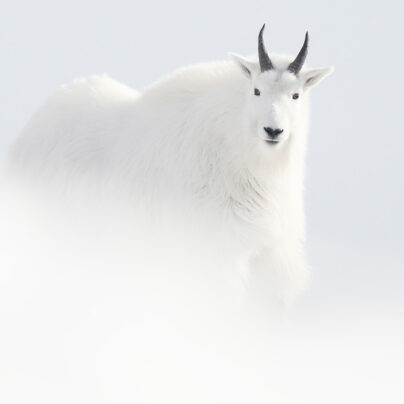A Smile in the Ice
Learning a New Way of Life With the Nenets
Story & Photography by Gabriele Pedemont // Written by Marta Manzoni
I hate the cold. It has always scared me. I live in Liguria and for me winter means 15°C, but here the temperature ranges from –25°C to –50°C. I always have at least four layers on: merino wool underwear, a layer of technical underwear, a fleece sweatshirt, and another warm and furry sweatshirt. On top of that, I have a high-altitude parka. The cold, no matter how dry, burns.
Chapter one | The cold burns
I know I am not the first to photograph the Nenets – the most beautiful images I saw before leaving were by Sebastião Salgado – but I wanted this trip. It would be something new, a challenge to myself: something very different to my previous experiences in Asia and Africa. All in warm places.
I leave Milan, destination Moscow, then a domestic flight to Salekhard: the last village before the tundra. I’m excited. I haven’t travelled in two years due to the pandemic. To reach the Nenets we use TREKOLs: off-road vehicles made in Russia with six-wheel drive, weighing two tons, which can float on water and move well on ice and snow. It is not a comfortable journey. I’m in the far back of the bouncing vehicle and I feel like throwing up – carsick for the first time in my life. There are no seats, only two side benches. I’m looking for something to cling to but there’s nothing, not even any windows. We are locked inside a box with suitcases and backpacks flying all over the place. Eventually we wedge ourselves against each other to stay as still as possible.
Our journey on the TREKOL takes 12 hours. Towards the end I can’t take it any more and ask to sit in the front.
Chapter two | Nomad life
There are four hours of light per day. We arrive in the middle of the night, or so I think; the darkness is total. It’s freezing as we slip inside the chum, a kind of conical tent structure made of poles and covered with reindeer skins. There’s a firebox in the centre and the smoke comes out through a hole at the top. Wooden planks cover the floor. Reindeer skins act as both mattress and blanket. But we’re sneaking into the home of strangers in the middle of the night, and there is a moment of clumsy embarrassment before our hosts greet us warmly, supplementing their words with gestures. The Russian interpreter helps us with the language, but their meaning is clear: you are welcome.
Each chum houses one or two families – three to eight people – and this settlement has two tents. It is immediately clear that the Nenets are very practical people. When we enter with boots covered in snow, they show us a stick at the entrance for hitting the soles to avoid tracking snow inside. The women are almost always inside, taking care of the chum; they clean, cook, do the dishes, mend and sew clothes and accessories. I sit with Svetlana, a young woman with red cheeks and deep, dark eyes, watching her work. Absorbed in her task, she’s quiet and rarely speaks to me. When the women go out it is usually to help out with the wood, which is critical to their daily lives and requires a lot of energy to both gather and chop. Men hunt hares and foxes, fish, and tend the reindeer.
I go outside to watch the men divide the flock and lasso a reindeer. Seeing this animal being killed really hits me. There is no blood. They usually break the skull with a blow, but if it doesn’t die – like now – they choke it with a rope. It seems like such an ugly death. Nothing, however, is wasted. The antlers are removed to sell, and the skins are used to cover the chums, make blankets and traditional fur garments – malitsa – as well as boots, hats, and gloves. Tendons are turned into the lassos used to capture the reindeer; bones are used as tools and as raw material for manufacturing sleds. The meat is eaten straight away or frozen. I ask how long a reindeer will feed a family for, and the answer is about a month. I have not seen money here. I believe they mostly live by bartering.
When I ask to take a picture of husband and wife holding hands, they laugh, embarrassed. It’s clear from the moment we arrive that the children are loved by everyone, even other families. I play with them for hours. They have compulsory schooling, then decide whether to pursue a more Western lifestyle or be a reindeer herder. Many choose to carry on the tradition. They laugh a lot, fight in the snow, chase each other, jump into holes. When was the last time I saw children playing like this, outside and free? In Europe they always have phones or iPads in their hands.



Chapter three | Concert of silence
At night, the silence outside the tent is crazy. It doesn’t compare to the silence I’m accustomed to experiencing in Europe – it’s something else, evoking a feeling of real peace. We’re surrounded by a vast landscape and everything is etched by moonlight. The spaces are infinite. There is no horizon; I feel like I’m on the moon. No internet or phone signal reaches this place.
During the Soviet regime the Nenets were subjected to forced collectivisation and persecution. Today they’re threatened by climate change and the Russian army, who have closed part of the peninsula to make way for a large gas field. Life is hard, conditions extreme. The Nenets have very little – a tent, some reindeer, a few blankets – yet I have found them calm and peaceful. And they have fun with life. I rarely see anyone without a smile, not only for visitors like us but also for each other. Every moment I spend in their company reinforces my impression that they are a strong, proud people, yet also hospitable, sweet, and kind. It makes me think about how unhappy we are in Europe.
Throughout their lives, these nomadic people travel thousands of kilometres on sleds, drawing the symbol of infinity on the tundra. During the winter they trace part of the curve, and at the meeting point between the two halves they leave their winter clothing and some of their sleds, preparing for the warmer months by carrying only their lightest clothes. Throughout their lives they repeat the same actions. It’s all they know. Thinking about my own lifestyle, it seems terrible to me that they don’t see the world, but perhaps the less you have the better off you are. At least, that’s what I think when I see them so happy.
Chapter four | Reindeer stew
Dogs play a vital role here. Each family has at least three or four Samoyed: fluffy, white, intelligent, cheerful animals that nomadic shepherds raise to help with their flocks and pull the sleds. Some Samoyeds are able to herd reindeer without the men. At night they stay outside the chums to keep watch, but when the temperature drops to –50°C they retreat inside. The chum’s stove is always burning, except at night, when the temperature in the tent drops to –10°C. Fortunately, I have brought a high-altitude sleeping bag.
There’s no shower; I wash myself using wet wipes. I don’t know how the Nenets do it. To make drinking water, the women take blocks of ice and melt them in pots over the fire, and we drink tea – with biscuits – at any and all times of day. The menu includes reindeer pasta, reindeer soup, reindeer rice, and reindeer stew.
After a while, the constant darkness gets me out of sorts; I never know if it’s time for breakfast or an afternoon snack. Each day at 10.00am the sun begins to peep above the frozen horizon, layering the landscape with gold, and we try to make the most of the few hours of daylight to get the necessary work of life done. There’s no reliable electricity here – we only have a generator, which doesn’t always fire up. They use oil lamps; we use head lights.
I see for myself the Nenets’ skill as fishermen when we take the TREKOL and snowmobiles to the frozen lake. A few days ago, they bored holes in the ice about 30m apart and inserted two poles for hanging a net in between. The fish only beat for a few seconds. The water is warmer than the air, and at –30°C they immediately freeze.



Chapter five | Frozen cameras
When it comes to camera equipment, I don’t skimp, yet shooting in these temperatures is like nothing else. At –45°C the autofocus is a lot less reliable. Sometimes the viewfinder freezes. Power lasts only a few minutes; the only way to take a few more shots is to keep the batteries as warm as possible, in close contact with the body. I use power banks to charge the cameras. The gloves I wear are specially made for shooting in extreme temperatures; they’re merino wool, with a mitt covered in goatskin and a zip that opens for your fingers. I try to photograph like this, but my skin burns as soon as it comes into contact with the air. I can’t do it – so I learn to press the shutter with my whole hand inside the glove. Sometimes I’m forced to aim the camera at random because I can no longer see anything through the ice in the viewfinder.
The Nenets are eager to be photographed, and the light, when it shows in the sky at all, is perfect – a low, warming glow from a sun that never climbs high above the horizon. As a photographer, my problem is that everything in this landscape is white, so I must compensate for my camera’s meter readings. I have to be careful not to overexpose too much otherwise I risk burning details in the highlights. I can’t miss a beat. In Asia and Africa the challenge was in simplifying composition; I had to be careful because there were too many people and distracting elements. Here the scenes are empty. Composition is a strikingly different experience. I take a picture of my cameras – they are all white, completely frozen.
Chapter six | Gratitude
Returning to the chum in the middle of the night, after photographing the Northern Lights, I can no longer feel my feet. It’s as if I’m walking on my ankles. I notice that Svetlana is sitting at the far side of the chum, wrapped in furs, her head enveloped in a fox-fur hood; there’s a young dog on her lap, lying there peacefully while she strokes its ears. When she sees me, the silent woman gets up and walks over, then wordlessly begins to massage my feet. For the first time I see her offer me a faint smile. She fires up the stove, but signals for me not to keep my feet too close and to keep moving them. For half an hour I do what she says while she scrutinises me. The dog yawns on her lap and enjoys the cuddle. Then she approaches once again, takes my bare feet in her hands, feels that they’re warm, gives me a smile, and returns to the other side of the chum. This woman, whose quietness I had earlier interpreted as distance, is worrying about me. It’s a very sweet gesture.
I don’t want to leave. I have loved testing myself. In life, we often set our own limits. We have too much, in every sense, but nothing is ever enough. All too often we lack gratitude for life, even if we have health, a roof over our heads, a family, a full fridge, a job. These are the important things – everything else is secondary. When I return home, I take stock and realise how lucky I am. I often lose sight of the things that matter and let myself be carried away by our society’s lifestyle, by social networks, by advertising. In the past I thought I wasn’t enough, for myself or for others. After this journey I feel more peaceful. More relaxed. I am happy with what I have and who I am. It doesn’t take much to be happy.
First published in Sidetracked Volume 23
From December 13th to 23rd, 2021, Italian photographer Gabriele Pedemonte lived with the Nenets, a nomadic population of the Yamal Peninsula in the deep north of Siberia. He shot at –50°C, learnt about a new way of life, and discovered that it doesn’t take much to be happy.
Gabriele Pedemonte // @gabriele_pedemonte
Marta Manzoni // @_marta_manzoni




